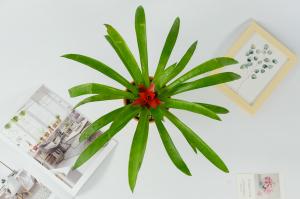A Red Eye Tree Frog Inside a Plant
The red eye tree frog, also known as the red-eyed leaf frog, is a stunningly beautiful and iconic amphibian found in Central and South America. They are often brightly colored with a vivid green body, orange or yellow feet, and of course, their most distinctive feature - bright red eyes. These eyes are not just for show - they enable the frog to see in the dark, which is particularly beneficial since they are nocturnal creatures.
One fascinating aspect of the red eye tree frog's behavior is their ability to hide in plain sight. They are known for their amazing camouflage skills and can blend seamlessly with their surroundings, often hiding amongst foliage or inside plants. In fact, it is not uncommon to find a red eye tree frog inside a plant in their natural habitat.
Adaptations for Life in Trees
Red eye tree frogs are arboreal creatures - they live in trees - and have a number of adaptations that make it easier for them to survive in this environment. One of these adaptations is their sticky toes. The pads on their toes are covered in tiny suction cups, which allow them to climb and cling to smooth surfaces, such as leaves and branches.
Another adaptation is their large eyes, which not only help them to see in the dark but also give them a wide field of vision. This is particularly useful when jumping from tree to tree, as it allows them to accurately judge distances and avoid potential predators.
A Unique Reproductive Strategy
Red eye tree frogs have a unique reproductive strategy, which involves the female laying her eggs on the underside of a leaf overhanging a body of water. Once the eggs hatch, the tadpoles fall into the water below, where they continue to develop into fully grown frogs.
This strategy carries a certain amount of risk for the tadpoles, as they are vulnerable to predators in the water. However, it also ensures that the young have a plentiful supply of food, as there are often ample insects and other small creatures in the water for them to eat.
The Importance of Conservation
Like many other amphibian species, the red eye tree frog is facing threats to its survival, primarily due to habitat loss and pollution. As a result, it is considered to be a near-threatened species by the IUCN Red List.
Conservation efforts are therefore crucial in order to ensure the long-term survival of these stunning creatures. This may involve protecting their natural habitats, reducing pollution levels, and even captive breeding programs to help increase their numbers.
In Conclusion
The red eye tree frog is a truly fascinating and unique species, with a range of adaptations that make it perfectly suited to life in the trees. Its striking appearance, incredible camouflage skills, and unusual reproductive strategy are just a few of the many things that make it a popular subject for study and conservation efforts. With sustained efforts to protect its natural habitat and ensure its survival, we can hopefully continue to enjoy the beautiful sight of a red eye tree frog inside a plant for generations to come.

 how many times do yo...
how many times do yo... how many planted tre...
how many planted tre... how many pine trees ...
how many pine trees ... how many pecan trees...
how many pecan trees... how many plants comp...
how many plants comp... how many plants can ...
how many plants can ... how many plants and ...
how many plants and ... how many pepper plan...
how many pepper plan...





























